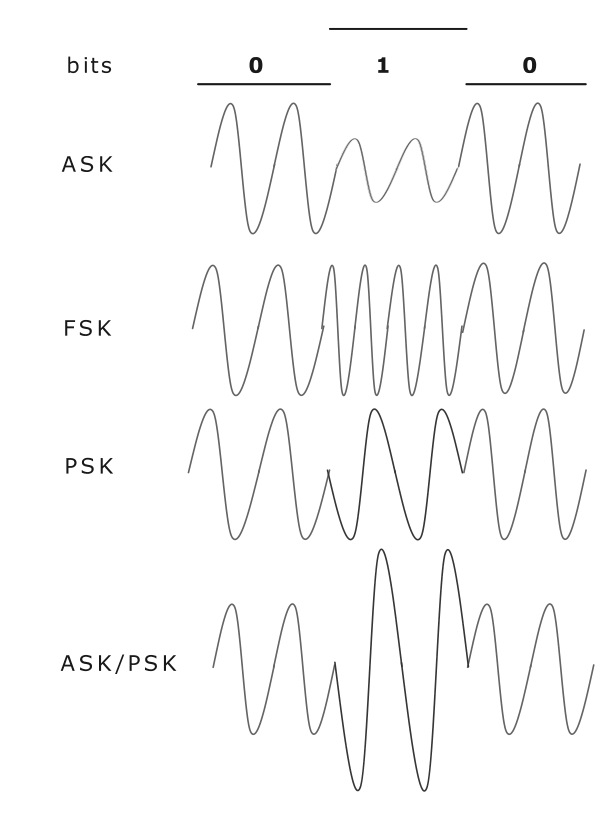Radio modulation
 In the comments on the article “Signal Quality Criteria in WiMax Networks” zlyoha complained about the lack of articles describing the physical side of transmitting information on a radio channel.
In the comments on the article “Signal Quality Criteria in WiMax Networks” zlyoha complained about the lack of articles describing the physical side of transmitting information on a radio channel. We decided to correct this omission and write a series of posts on wireless data transfer.
In the first of them, we will talk about the main aspect of transmitting information through a radio signal - modulation.
Modulation (lat. Modulatio - dimension) is the process of changing one or more parameters of a high-frequency carrier wave according to the law of a low-frequency information signal.
The transmitted information is embedded in the control signal, and the role of the information carrier performs high-frequency oscillation, called the carrier.
Modulation can be carried out by changing the amplitude, phase or frequency of the high-frequency carrier.
This technique provides several important advantages:
- Allows you to generate a radio signal that will have the properties corresponding to the properties of the carrier frequency. About the properties of waves of different frequency ranges can be found, for example, here .
- Allows the use of small antennas, because the size of the antenna should be proportional to the wavelength.
- Avoids interference with other radio signals.
The data stream transmitted in WiMax networks corresponds to a frequency in the region of 11 kHz. If we try to transmit this low-frequency signal through the air, we will need an antenna of the following sizes:

An antenna 24 km long does not seem convenient enough to use.
If we transmit this signal superimposed on a carrier frequency of 2.5 GHz (the frequency used in Yota WiMax), then we need an antenna 12 cm long.
Analog modulation.
Before going directly to digital modulation, I will give a picture illustrating analog AM (amplitude) and FM (frequency) modulation, which will refresh many school knowledge: the

original signal

AM (amplitude modulation)

FM (frequency modulation)
Digital modulation and its types.
In digital modulation, the analog carrier signal is modulated by a digital bitstream.
There are three fundamental types of digital modulation (or encryption) and one hybrid:
- ASK - Amplitude shift keying.
- FSK - Frequency shift keying.
- PSK - Phase shift keying.
- ASK / PSK.
I mention that there is a tradition in the Russian terminology of radio communications to use the term “manipulation” to modulate a digital signal.

In the case of amplitude encryption, the signal amplitude for a logical zero can be (for example) two times less than a logical one.
Frequency modulation in a similar way represents a logical unit with an interval with a greater frequency than zero.
Phase encryption represents “0” as a signal without a shift, and “1” as a signal with a shift.
Yes, here we are dealing with a “phase shift” :)
Each of the schemes has its own strengths and weaknesses.
- ASK is good in terms of bandwidth efficiency, but is subject to distortion in the presence of noise and is not efficient enough in terms of power consumption.
- FSK - exactly the opposite, is energy efficient, but does not use the frequency band effectively.
- PSK is good in both aspects.
- ASK / PSK is a combination of two schemes. It allows even better use of the frequency band.
The simplest PSK scheme (shown in the figure) has its own name - Binary phase-shift keying. A single phase shift is used between “0” and “1” - 180 degrees, half the period.
There are also QPSK and 8-PSK:
QPSK uses 4 different phase shifts (quarter-period) and can encode 2 bits in a character (01, 11, 00, 10). The 8-PSK uses 8 different phase shifts and can encode 3 bits per character.
More details here
One of the private ASK / PSK implementations called QAM is Quadrature Amplitude Modulation (QAM). This is a method of combining two AM signals in one channel. It doubles the effective bandwidth. QAM uses two carriers with the same frequency but with a difference in phase by a quarter period (hence the word occurs quadrature). higher levels of QAM are built on the same principles as the PSK. If you are interested in the details, you can find them on the net without any difficulty.
the theoretical efficiency of prop band Kania:
| Format | Efficiency (bit / s / Hz) |
| Bpsk | 1 |
| QPSK | 2 |
| 8-PSK | 3 |
| 16-qam | 4 |
| 32-qam | 5 |
| 64-qam | 6 |
| 256-QAM | 8 |
The more complex the modulation scheme, the more detrimental it is caused by transmission distortions, and the smaller the distance from the base station at which the signal can be successfully received.
PSK and QAM schemes of an even higher level are theoretically possible, but in practice when using them too many errors occur.
Now that we have covered the main points, we can write what modulation schemes are used in WiMax networks.
Signal modulation in WiMax networks.
WiMax uses “dynamic adaptive modulation”, which allows the base station to choose between bandwidth and the maximum distance to the receiver. To increase the range, the base station can switch between 64-QAM, 16-QAM and QPSK.
Conclusion
I hope that I have managed to strike a balance between the popularity of the presentation and the technical nature of the content. If this article is in demand, I will continue to work in this direction. WiMax technology has many nuances that you can talk about.
